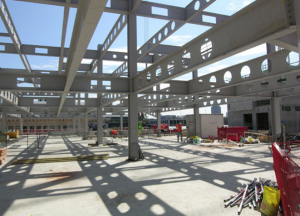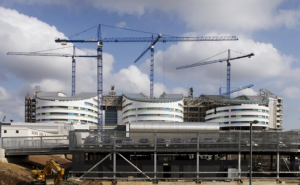
Growth of construction industry dependent on huge infrastructure projects
Britain’s construction industry has been predicted to grow an average of 1.7% over five years, and the overall rise of the workforce over the last three years is at nearly 5%, according to the Labour Force Survey. However, it is heavily dependent on a few huge infrastructure projects.
The Construction Industry Training Board (CITB) has found in its latest annual report that the sector is predicted to continue to grow over the coming five years with a total of 179,000 jobs created.
Although, infrastructure work will account for almost half of 2017-2021 construction growth with big projects like the High Speed 2 rail link, Hinkley Point and Wylfa nuclear power stations projects.
In recent years Private Sector housing developers have driven the industry but now the construction industry’s future is heavily dependent on these large politically sensitive infrastructure projects beginning on time.
The report makes it clear that there is uncertainty as to what weight should be put upon the forecasts as it states, “all predictions for the construction sector are made against a backdrop of ongoing political and economic uncertainty.” The report goes on to describe Britain’s vote to leave the European Union as “one of the most significant unknowns.”
Furthermore, total construction output for 2021 could be 0.8% lower than currently predicted if Hinkley was to be taken out of the pipeline. Therefore, any changes made to large infrastructure projects would be felt throughout the industry. Equally, Controls on immigration would also affect the sector, due to its current reliance on foreign construction staff.
CITB’s Chief Executive, Sarah Beale adds that “we will be working with our industry to understand what it means for out migrant workforce and what we must do to attract and grow more of our own.”
The report also states that the public sector work is likely to stagnate over the forecast period with the output growth at an average of 1% up to 2021. Additionally, it was reported that the industrial sector is set to be the weakest performing with an averaging a 1.4% decline.
With Wales predicted to grow by 6.2%, and Scotland to decline by -0.4% each year, the picture across the regions of the UK is extremely varied. London however is predicted to remain a strong performer, growing by 2.4% each year, with employment growing by 6.6%. The Southwest (3.1%), the Northwest (2.5%) and the Southeast (2.2%) are expected to perform well, in England.
Sarah Beale explained, “while we are forecasting slower growth for our industry than we were last year, employers will still be creating tens of thousands of new jobs. We will be working with employers to attract new talent into our industry and to train them for rewarding careers in the sector.”
Latest news

18th April 2024
Abloy UK showcases new digital portfolio at The Security Event 2024
Abloy UK is set to unveil its latest line-up of access control systems at The Security Event 2024, welcoming guests to explore its cutting-edge electromechanical and digital solutions on stand 5/F50.
Posted in Access Control & Door Entry Systems, Architectural Ironmongery, Articles, Building Industry Events, Building Industry News, Building Products & Structures, Building Services, Doors, Exhibitions and Conferences, Facility Management & Building Services, Health & Safety, Information Technology, Retrofit & Renovation, Security and Fire Protection
18th April 2024
Strand is a Failsafe Choice for Emergency Exit and Panic Hardware
In times of emergency, you’re in safe hands with Strand Hardware. Although there are many considerations for building specification, few decisions can be as critical as selecting the right emergency exit/panic hardware.
Posted in Access Control & Door Entry Systems, Architectural Ironmongery, Articles, Building Industry News, Building Products & Structures, Building Services, Doors, Facility Management & Building Services, Health & Safety, Restoration & Refurbishment, Retrofit & Renovation, Security and Fire Protection
18th April 2024
MRA appoints Callum Budd as Research Projects Director
MRA Research, the research agency focused solely on the construction sector, welcomes Callum Budd as its new Research Projects Director.
Posted in Articles, Building Industry News, Information Technology, news, Recruitment, Research & Materials Testing
16th April 2024
Mitsubishi Electric set to host CIBSE Journal webinar
Mitsubishi Electric will host a CIBSE Journal webinar on Wednesday 24th April 2024 at 1pm to discuss the legislation and initiatives driving changes in the way we will need to heat, cool and ventilate large commercial buildings to reach net zero emissions in the UK.
Posted in Air Conditioning, Articles, Building Industry Events, Building Industry News, Building Products & Structures, Building Regulations & Accreditations, Building Services, Facility Management & Building Services, Heating Systems, Controls and Management, Heating, Ventilation and Air Conditioning - HVAC, Information Technology, Pipes & Fittings, Plumbing, Seminars, Sustainability & Energy Efficiency, Training
 Sign up:
Sign up: 

